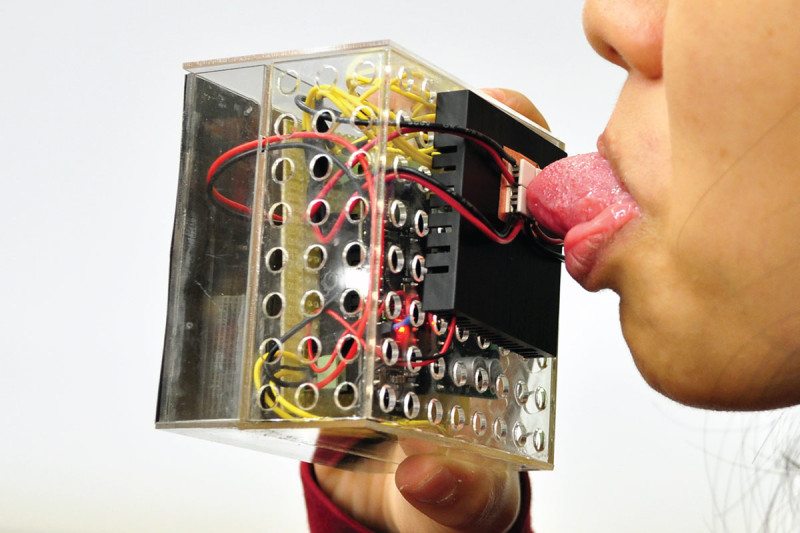Facial electrodes allow you to chew and feel the taste in virtual reality

Virtual reality is now becoming more accessible to the average user. The number of different kinds of VR devices is constantly increasing, they are becoming cheaper, and their capabilities are expanding. The image of objects in virtual reality is gradually approaching ordinary reality. And although it’s still far away from full immersion in VR, the developers are trying to bring this moment closer.
We are talking not only about vision and hearing, but also about taste. Imagine that in any virtual game you are taking part in a banquet or just having dinner. Before you - a realistic image of delicious food. Usually in games, when we see this, it remains to be content with a high-quality picture. But now, probably, it will be possible to try virtual food. The user, thanks to special electrodes, will be able to feel not only the taste, but even the structure (fiber, softness, etc.) of the products that it consumes.

')
All this becomes possible thanks to a special electronic system deceiving the organs of taste and touch. According to the developers, the technology can be used not only in games, but also, for example, in cases where a person can not have any products, but really want to. In addition, you can imagine a virtual advertising, where the products offered can be tried before the purchase or the “virtual restaurant” service. It can be presented the most rare and unusual dishes of the world that a person could try.
Implementation of such projects will have to wait, because there is no technology of such a level yet. But this sphere is already beginning to develop actively. Developer Nimesha Ranasinghe ( Nimesha Ranasinghe from National University of Singapore has been experimenting with digital candy for some time, which emulates different tastes and with a spoon equipped with electrodes. Such a spoon enhances some tastes, including salty, bitter or sour. Worst for some reason it turns out to emulate a sweet taste. But all this works in one way or another, so you can think about the practical implementation of the technology. As for sweetness, here you can probably think about patients with sugar diabetes beta, which can feel the sweet taste without consuming sugar or sugar substitutes.
Ranasingh together with her colleague Ellen Yi-Luen Do ( Ellen Yi-Luen Do ) after the completion of the project on electrical stimulation of taste sensations developed an addition to the technology.
Instead of electricity, they began to use temperature, deciding to use thermal instead of electrical simulation. The new project was presented in Tokyo, at the event ACM User Interface Software and Technology Symposium (UIST). Thermal simulation of taste, according to the developers, works fine with a sweet taste. In order for this to work, the user must place the tip of the tongue on a square with thermocouples that quickly heat up or cool down, tricking sensory neurons that play an important role in taste sensations.
At the initial stage of the project, thermal simulation worked only on half of the volunteers. Some project participants reported that with a stronger element heating (around 35 ° C), they felt the taste of spices (in this case, pepper). When cooling the thermoelement to 18 ° C, some participants in the experiment felt a mint flavor. The developers believe that thermoelements of this type can be embedded in glasses or cups so that a person can feel the sweeter taste of the drink without adding large amounts of sugar or sweeteners. Similarly, the product can be made more salty. This will be useful for, for example, patients who are harmful salty food.
Taste sensors can be fooled by the influence of electricity, but food is not only taste - food structure is also very important.
The simulation of the structure of food involved the authors of another project, which was called the Electric Food Texture System. Arinobu Nihima (Arinobu Niijima) and Takefumi Ogawa Takefumi Ogawa from Japan also use electrodes and electricity. But instead of the tongue, they apply electrodes to the chewing muscles in the jaw. When exposed to electricity, muscles contract in a special way, giving a false sense of the structure of food when chewing. “There is no food in the mouth, but the person feels like chewing on some food, thanks to an electrical simulation of the chewing muscles,” says Nihima.
In order to give a person a feeling of solid food when chewing, the muscles are subjected to a pulsating electrical charge. In order to simulate soft food, the frequency of pulsations is reduced. According to the developers, the greatest effect was achieved in terms of simulating chewing gelatin candies. If desired, the same technology can deceive the human senses when chewing on real food. The same candies, which are only real, can be made to seem firmer or softer to a person.
In general, all this is applicable for use in virtual reality. Not only for games, but also for practical purposes. Those astronauts, for example, will be able to visit their virtual home, or any other favorite place, as well as enjoy virtual coffee. Now it does not seem impossible at all.
Source: https://habr.com/ru/post/399025/
All Articles